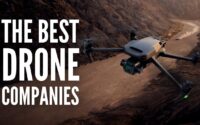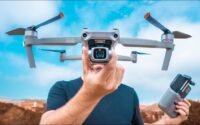The Remarkable Abilities of Drone Bees
Drone bees can fly and their main role is to mate with the queen for reproduction. They have larger bodies, bigger eyes, and lack stingers. Mating flights are crucial for their survival, but only a few drones are successful.
Can Drone Bees Fly?
Yes, drone bees can fly. Drones are male bees in a honey bee colony. They play a vital role in the reproductive process of honey bees. Unlike worker bees, drones do not have stingers, pollen baskets, or wax glands.
Drones’ main purpose is to mate with virgin queens from other colonies. They are larger than worker bees and have bigger eyes to help them spot the queens during flight. Drones usually gather in specific areas known as drone congregation areas.
When a drone senses a virgin queen’s pheromones, it joins other drones in pursuing her. The fastest and most agile drones have a higher chance of mating. However, only a few drones are successful, as the queen mates with multiple drones in mid-air.
During mating, drones transfer sperm to the queen through their reproductive organ called the endophallus. After mating, the drone dies, as its endophallus detaches from its body. This sacrifice ensures the continuation of the colony’s genetics.
Drone bees’ flying ability is crucial for their reproductive function. They are capable of flying at high altitudes and reaching drone congregation areas, sometimes several kilometers away from their home colony. Their flight skills allow them to locate and mate with queens from other colonies, contributing to genetic diversity.
Despite their importance in the mating process, drones do not contribute to other colony activities such as foraging, nursing larvae, or protecting the hive. Their sole purpose is to mate and ensure the survival of the honey bee population.
The Role of Drone Bees
Drone bees – also known as male bees – play a crucial role within the bee colony. Unlike worker bees, they don’t gather nectar or pollen, and they lack a stinger. Instead, their primary function is reproduction.
- Drones are responsible for mating with the queen bee, ensuring genetic diversity within the colony.
- They have larger eyes, enabling them to spot potential mates while flying high in the air.
- Drone bees are larger and bulkier than worker bees, with stout bodies and broader abdomens.
- Since they lack pollen baskets and specialized structures for gathering resources, drones depend on workers for food.
- The drones’ sole purpose is to mate with a virgin queen, and they die shortly after successful copulation.
- During the mating flight, multiple drones pursue the queen, forming a drone congregation area where she selects her mates.
- After mating, the drones’ reproductive organs are torn off, leading to their inevitable demise.
- The role of drone bees is critical for colony survival, as successful mating ensures the production of fertilized eggs.
- However, excessive drone production can strain the resources of the colony, leading to potential conflicts with worker bees.
- Beekeepers sometimes employ artificial insemination techniques to control the number and quality of drone offspring.
- Studying the behavior and biology of drone bees helps researchers gain insights into bee genetics and population dynamics.
- The presence of drones also indicates a healthy and well-balanced bee colony, as they signify a successful and robust queen.
Anatomy and Physiology of Drone Bees
Can drone bees fly? Yes, they can. Drone bees are male bees in a honey bee colony. They have larger bodies than worker bees. -Drones have longer wings and bigger eyes than worker bees. -Their primary role is to mate with the queen bee. -Drone bees do not have stingers. -They do not collect nectar or pollen like worker bees. -Their main purpose is reproductive. -Drones leave the hive and fly in search of virgin queen bees. -During mating, they transfer sperm to the queen bee. -After mating, drones die as their reproductive organs are torn from their bodies. -The anatomy of drone bees includes a thorax, abdomen, head, wings, and legs. -Their thorax houses powerful flight muscles, enabling them to hover and fly. -Their wings beat at a slower rate compared to worker bees. -Drones have large compound eyes that help them locate potential mates. -They have no wax glands and cannot produce beeswax. -Drone bees have a shorter lifespan compared to worker bees. -They are expelled from the hive during winter or when resources are scarce. -Understanding the anatomy and physiology of drone bees is crucial for studying honey bee behavior and colony dynamics.
Flight Capabilities of Drone Bees
Can drone bees fly? Absolutely! Drone bees possess remarkable flight capabilities, allowing them to navigate the skies with agility and precision.
First and foremost, drone bees are adept at hovering in mid-air, enabling them to maintain stability and hover over specific areas for extended periods. This skill is crucial during their mating flights, as they need to remain airborne while searching for potential queen mates.
Drone bees are also capable of flying at impressive speeds. With their powerful wings, miles per hour, making them swift aerial creatures. This speed allows them to cover large distances in search of food sources and new habitats.
Moreover, drone bees exhibit excellent maneuverability. They can make sharp turns, fly in tight circles, and change direction swiftly, thanks to their flexible wing joints. This agility helps them avoid obstacles and navigate through complex environments, ensuring their safety during flight.
Although drone bees are not equipped with pollen-carrying structures like worker bees, they do possess the ability to fly to flowers and collect nectar. This foraging behavior enables them to contribute to the pollination process, albeit to a lesser extent than worker bees.
It is important to note that drone bees have relatively shorter flight ranges compared to worker bees. While worker bees can travel several miles away from the hive, drone bees tend to stay closer to their home colony. This behavior aligns with their primary role in reproduction rather than foraging and resource gathering.
Limitations in Drone Bee Flight
-
Physical Limitations – Drone bees, being larger and heavier than worker bees, face certain physical limitations during flight. Their larger bodies and shorter wingspan make it more challenging for them to maneuver and maintain stability in the air.
-
Aerodynamic Constraints – The design of drone bees, with their rounder bodies and shorter wings, affects their aerodynamic efficiency. This results in reduced lift and increased drag, making it harder for them to achieve sustained flight and maneuverability.
-
Endurance and Stamina – Compared to worker bees, drone bees have limited endurance and stamina when it comes to flying. Their larger bodies require more energy to stay airborne, which means they can only fly for short durations before needing to rest and replenish their energy.
-
Speed Limitations – Drone bees are generally slower in flight compared to worker bees. Their larger size and less efficient wing design make it challenging for them to attain high speeds, limiting their ability to cover long distances efficiently.
-
Weather Sensitivity – Drones are more sensitive to adverse weather conditions, such as strong winds and rain, due to their physical limitations. These conditions can significantly impact their flight stability and even prevent them from flying altogether, reducing their overall effectiveness in pollination activities.
-
Navigation Challenges – Drones lack the same level of navigational abilities as worker bees. They rely on visual cues and landmarks to navigate, which can be challenging in unfamiliar environments or areas with limited visual references.
-
Pollination Efficiency – While drones can carry pollen, their larger body size and less efficient flight capabilities make them less adept at reaching deep into flowers and effectively transferring pollen from one flower to another. This reduces their efficiency as pollinators compared to worker bees.
-
Lifespan – Drone bees have a relatively short lifespan compared to worker bees. Once their primary role of mating with a queen bee is complete, they are typically expelled from the hive, and their life expectancy dramatically decreases. This limited lifespan restricts their overall contribution to pollination efforts.
Flight Distance and Speed
Drone bees, unlike worker bees, have larger bodies and heavier weights, which affect their flying capabilities. Due to their size, they generally have a shorter flight distance compared to worker bees. On average, meters before they need to rest and recharge.
In terms of speed, drone bees are not as fast as worker bees. They fly at a slower pace, kilometers per hour. This reduced speed is due to their larger bodies and the energy they allocate towards mating rather than foraging for nectar and pollen.
Mating Flights
Can drone bees fly? Yes, they can. Mating flights are essential for the reproductive cycle of drone bees. During these flights, drones search for virgin queens, guided by pheromones and environmental cues. They take off from the hive and soar high into the sky, exploring vast territories. The drones compete with each other to mate with a queen, using their impressive flying skills. In the air, they perform acrobatic maneuvers, trying to attract the attention of the queen. These flights can reach incredible heights, as drones aim to maximize their chances of finding a queen. Mating flights are a critical event for drones as they only get one chance to mate before they die. If successful, the drone mates with the queen mid-air, transferring its genetic material. Once mated, the drone’s mission is complete, and it dies shortly after. These flights ensure genetic diversity within the bee population and play a crucial role in maintaining healthy colonies. However, not all drone bees get the opportunity to mate, as only a few lucky ones succeed. After the mating season, drones are usually expelled from the hive, as they are no longer needed. Overall, mating flights are fascinating natural events where drone bees showcase their flying abilities and contribute to the survival of their species.
The Fate of Drone Bees
Drone bees have larger bodies and eyes, which affect their ability to maneuver in the air. They are not equipped with pollen baskets or stingers like worker bees. While drone bees do have wings, they are often heavier and less efficient at flying, making them slower and less agile.
The inability of drone bees to fly as effectively as worker bees impacts their overall survival. For instance, during mating flights, drones need to chase and catch up with the queen bee in flight. Their slower flying speed can make it challenging for them to compete with other drones and successfully mate.
Furthermore, drone bees have a shorter lifespan compared to worker bees. They typically live for a few weeks, and their sole purpose is to mate with the queen bee. Once they have fulfilled their reproductive role, they die shortly afterward.
Efforts to protect and conserve drone bees, as well as their habitats, are essential for maintaining healthy ecosystems. Conservation measures can include creating bee-friendly environments with diverse plant species and minimizing the use of harmful chemicals in agriculture.



